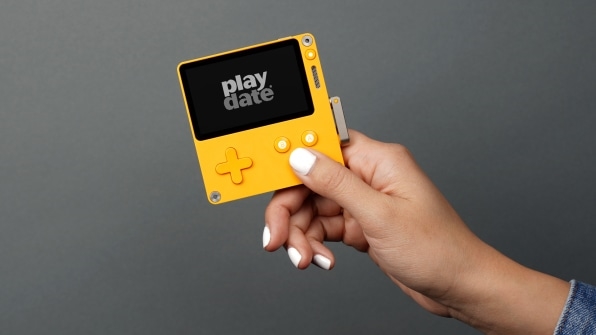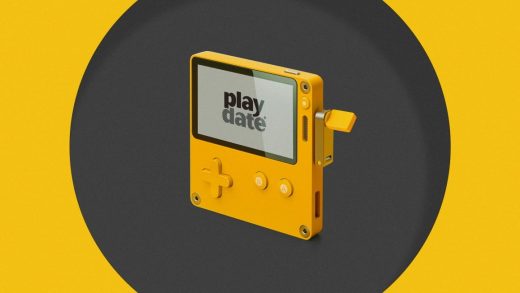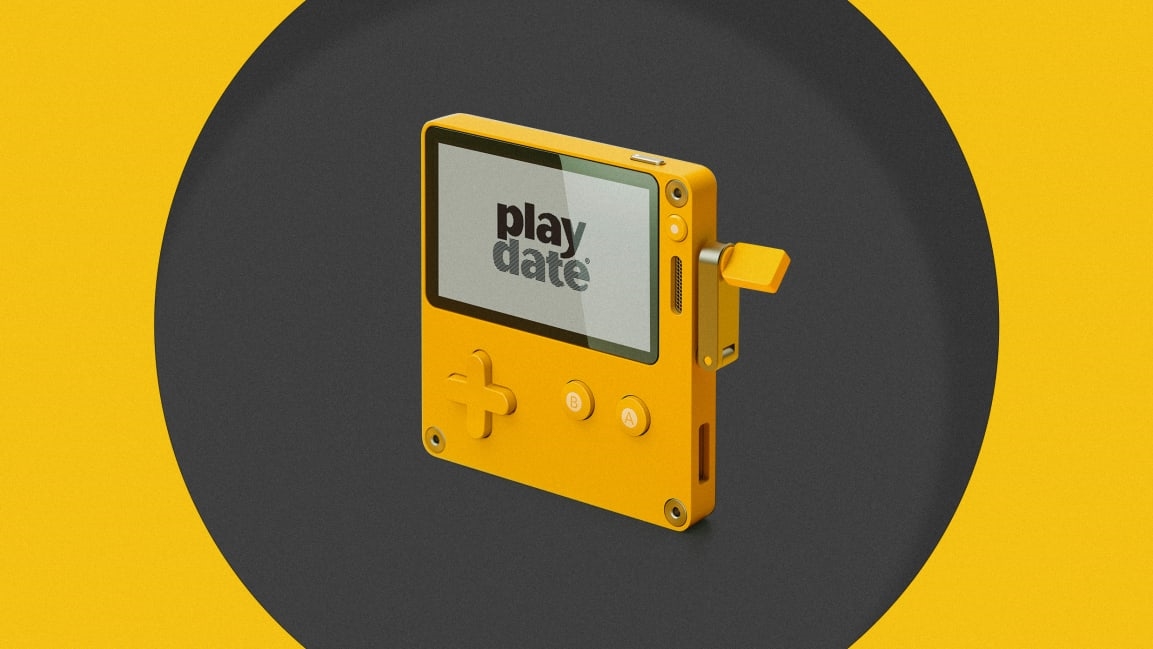The world’s most anticipated game console is a 1-bit handheld
Microsoft and Google are promising to stream vast, high-resolution games to smartphones in a race to become the Netflix of gaming. Sony recently teased a Playstation 5 that can illuminate 3D objects just as they are in Pixar films. Nintendo’s Switch has become the top-selling console with clever touch-screen hardware that works with or without a TV. And Oculus just built the first perfect VR system, no giant PC required.
But the hottest, most viral game console of the moment is none of these things. It’s the Playdate, a 3-inch-by-3-inch, dark canary yellow square. Expected next year for $150, the Playdate has a 1-bit black-and-white screen. It has a four-direction pad and just two buttons, much like an old NES controller. And it has a crank. The crank doesn’t charge the device like an emergency radio; it’s just a zany control scheme that’s supposed to be fun.
Playdate is just the sort of off-center hardware project that could only be borne from independent companies instead of the tech titans controlling the $135 billion video game industry. It’s almost designed from the ground up to be a cult product. Indie games. Indie hardware. Controls that can’t possibly work on other platforms. What vinyl is to music in 2019, Playdate is to game consoles.
The Playdate was born as a passion side project inside Panic, a software development studio best known for its critically acclaimed indie game Firewatch. As far back as 2015, the company pieced together a prototype for Playdate and began working on its own OS. But what it had built looked like a homemade Gameboy, with some cobbled together 3D printed controls and circuits. It was nothing particularly special.

[Photo: Playdate]
Panic began talking to the high-design synth developer Teenage Engineering, known for highly polished electronic music instruments like the OP1, about getting involved in some sort of hardware project–maybe not even a gaming hardware project–in 2011. Into 2015, that project solidified as a game console. “At the time we approached them, we had a rough idea that we wanted at least the ‘standard’ controls: a D-pad and two buttons,” says Greg Maletic, director of special projects at Panic and lead on Playdate. “It was Teenage Engineering’s idea to add a crank into the mix, which we immediately seized on as possessing just the perfect amount of cleverness and weirdness we were looking for. We knew not every game would need the crank, but the ones that did . . . wow, that would add an extra level of fun . . . It looked beautiful and desirable and we knew that we wanted one, even if we weren’t certain anybody else would.”
The hardware is still only a prototype, but like all of Teenage Engineering’s products, it looks like an anachronism: like a gadget from the future where smartphones never took over. The gloss of the device creates an irresistible, optimistic frame around the black-and-white screen. The screen, despite being low in resolution and lacking color, is still supposed to create an intriguing, high-contrast effect.
“[It’s] sharp. Reflective. High resolution, almost like an e-reader, but with a much higher frame rate than an e-reader,” says Maletic. “To be clear, we’re not trying to paper over its limitations. Like we say on our website, it isn’t back-lit, and it is, unquestionably, black-and-white only. But it does deliver an experience unlike anything else on the market. It’s a different kind of aesthetic.”
The hardware is meant to appeal to consumers and developers–and that’s key to Playdate’s business model. The Playdate will launch with a single game preloaded. Then each week, one of 12 exclusive games will download to your device via Wi-Fi. Panic was able to attract some superb game development talent for this model, including Keita Takahashi, known for creating the beloved game Katamari Damacy, which involved rolling up the world’s objects into a single, ever-growing ball. For Playdate, Takahashi is using the crank to make a game in which a character named Crankin’ moves forward and backward in time.
These games won’t be 100-hour, multiplayer epics, but they’ll be fun diversions, requiring very little overhead for developers to create because the low-fi hardware means advanced physics and graphics are off the table. “It does lower that barrier to entry,” says Maletic. “On a modern console like a PS4, you can do practically anything. And that’s amazing. But it’s also intimidating, and a whole lot of work. A Playdate game is smaller in scope, and it’s easier to just jump right in and make something fun.”
Panic declined to share details on revenue splits or other compensation offered to its developers. However, Maletic did confirm that the first 12 games will only represent the first wave release for Playdate. He hints that it’s likely that future packs of games will purchasable after they’re released.
Normally, I’d be skeptical about gaming hardware–which is notoriously tricky to launch. In 2012, an Android gaming console Ouya raised over $2 million in a day. only do be dead in the water by 2014. But Ouya had all sorts of red flags from day one. Android games aren’t necessarily designed to play with a controller on a TV. It was up against the cadence of every new Android phone that would have better processors and graphics chips. And having spoken to its creator at launch, it was clear the platform was designed for business goals–around revenue-generating micro transactions.
Playdate, on the other hand, is a smaller effort. It has some great developers lined up. Its hardware shouldn’t be too hard to build, and it’s found the partner to help build it, too. Its ambition isn’t to take over the world, but to create a unique, curated experience–something different from what you’d play on your TV or your phone. The catch is just whether or not you want to pay the equivalent of $12 a game for 12 games sight unseen.
And a lot still needs to be worked out. The Playdate hardware is being finalized, and the full game lineup has yet to be announced. But if the initial reaction I’ve seen on Twitter is any indication, there’s a lot of appetite for a quirky, portable, indie gaming machine full of boutique experiences you can’t get anywhere else. And while Playdate will certainly not unseat the corporate giants ruling video games today, it does seem to indicate that in the $135 billion video game industry, there really is room for everyone.
(29)



